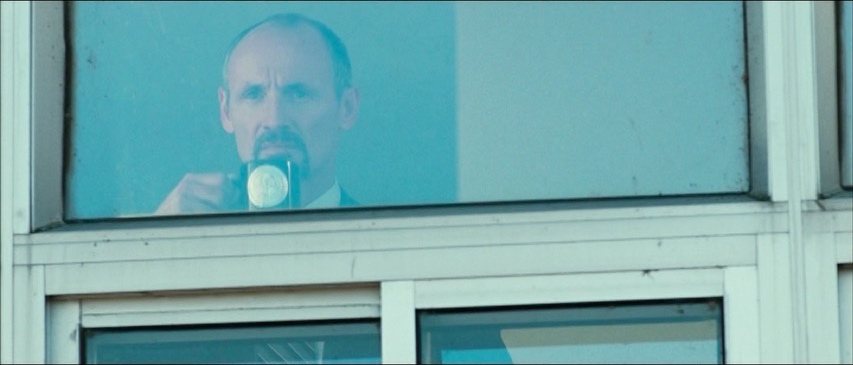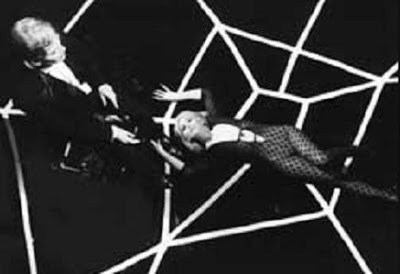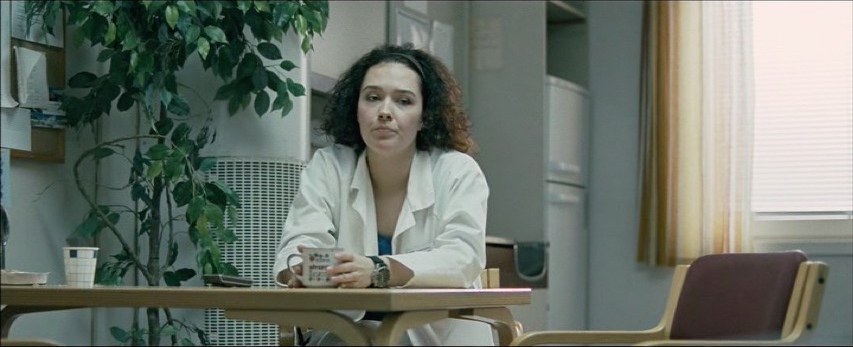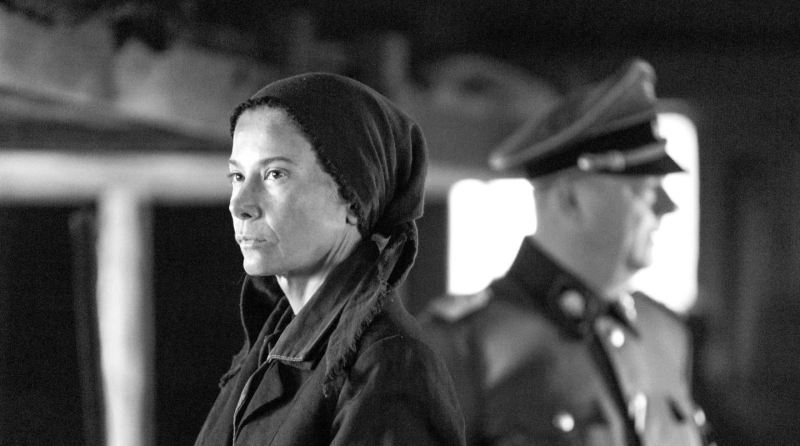« January 2018 | Main | March 2018 »
February 27, 2018
The Sect

La Setta
Michele Soavi - 1991
Doppelganger Releasing and Scorpion Releasing BD Region A
Dario Argento originated the story, served as producer, and has his name prominently featured on the posters. Be that as it may, there is enough difference here to mark The Sect as Michele Soavi's film. This isn't like the original film version of The Thing which looks and sounds enough like a Howard Hawks film that people are still arguing as to what Christian Nyby actually did, or Poltergeist, with Steven Spielberg second-guessing Tobe Hooper. The Sect is the last of his first three films to be made under the sponsorship of older filmmakers, with Stage Fright produced by Aristide Massaccesi, followed Dario Argento serving as producer on The Church and The Sect.
What struck me were the moments of quiet contemplation, dreamlike imagery, as well as use of religious symbolism. One of the first shots is with the camera following along a creek, with the water appearing to turn increasingly red. A superimposed title reads "South California 1970" (sic). Music is heard faintly, then more clearly recognized as the song, "A Horse with No Name". Animals are a significant part of this film. A family of hippies is camping out. A man dressed like a biblical character shows up asking for water. He introduces himself as Damon, a name that sounds almost like demon, and quotes from the Rolling Stone song, "Sympathy for the Devil". Damon looks kind of like Charles Manson. Most viewers can guess where this is leading.

Considering the use of animals and images of animals in The Sect, it's an uncanny accident that Kelly Curtis has the lead role here instead of the originally considered actress. Consider that her mother, Janet Leigh, portrayed a woman named Marion Crane in Psycho and was terrorized by giant rabbits in Night of the Lepus. Here the daughter is terrorized by a marabou stork, and has a pet rabbit. Curtis plays a teacher named Miriam, almost a homophone with Marion. Herbert Lom brings his own legacy as a creepy, if not villainous, stranger in Miriam's life. The narrative jumps to Frankfurt, Germany, 1991, with a murderer confessing to his crime compelled by outside forces.
There is lots of use of blue, especially in an oversized basement with walls that have artwork that resemble the stain glass windows of a church, The blue stringy substance that appears with the water in Miriam's house is echoed in a ribbon around her wrist. Doctors wear shiny blue scrubs. A dream sequence takes place in a lushly green field with eye popping red flowers. In addition to her pet rabbit, Miriam's house has images of rabbits on the walls and collection of rabbit figurines.
The dream sequence especially anticipates the kind of visual creativity Soavi would employ almost ten years later with his television film on St. Francis. There are the usual horror tropes with windows that burst open, doors that slam shut, and passageways that could well be portals to hell. The gorier elements are much briefer here than one finds in most Argento films. Unlike most films that involve devil worship, the religious aspects here are pre-Christian.
The blu-ray was made from a 2K scan from the original negative of the English language version. A supplement with actor Tomas Arana not only discusses his playing of Damon, but the differences as an actor in Italian and Hollywood productions. An interview with Michele Soavi covers the history of the making of The Sect as well as some of the films that served as inspiration.
Posted by Peter Nellhaus at 06:13 AM
February 25, 2018
Coffee Break

Margherita Buy in Viaggio Sola (Maria Sole Tognazzi -2013)
Posted by Peter Nellhaus at 08:59 AM
February 22, 2018
The Lodgers

Brian O'Malley - 2017
Epic Pictures
Twin brother and sister live in a huge, crumbling mansion in Ireland. One could fit the tiny, nearby village inside that entire house. The film takes place in 1920, though it's only the presence of newly returned soldier that offers any hint of the 20th Century. The twins, Rachel and Edward, are bound by a curse that demands the two be in bed by midnight, not let any strangers into the house, and threatens the life of the remaining twin should one of them leave. Edward constantly stays indoors. Rachel leaves during the daytime for necessary shopping. The two attempt to avoid the consequences of the family trust emptied of funds. Their lives are disrupted by Rachel's attraction to Sean, the returning soldier, and Bermingham, the hatchet faced debt collector.
Brian O'Malley's second feature doesn't have the overwhelming sense of dread as in his terrific debut, Let Us Prey. The screenplay, by David Turpin, owes a bit to Poe's Fall of the House of Usher both for the relationship between the brother and sister, and the house seeming to have a life of its own. Water seeps through a trap door on the main floor. Voices emanate from the darkest corners. Edward is sometimes so pale that along with his never leaving the house, suggests a visible ghostly presence. The idea of an enclosed world is stressed not only by the dimly lit interiors, but even the pathway to the mansion, walled in by the lush green trees.
O'Malley uses mirror images, mostly in the beginning. Water drips upwards. There are hints that this is a haunted house, but hints aren't enough for the literal minded contemporary film viewers. Psychological horror doesn't cut it when the demand is for CGI ghosts. O'Malley's stated goal was to make a film akin to Jack Clayton's The Innocents. While his film falls short, it's better than the remake of The Haunting which took the suggested horror of Shirley Jackson into an unsubtle extravaganza of special effects.
Mirroring is also part of the narrative. Simultaneous to Edward and Rachel's virtual imprisonment by malevolent forces inside the house are the hostile villagers that threaten Rachel. That Sean returns from World War I with a prothetic leg is a reminder of some of the real horrors of the outside world.
O'Malley was particularly lucky in his casting. Charlotte Vega and Bill Milner look like they could actually pass for siblings. As the debt collector, David Bradley resembles the kind of miserly character from a Dickens novel. David Turpin also contributed to the music, most notably with a song co-written with Irish musician Cathey Davey, detailing the family curse.
Posted by Peter Nellhaus at 07:32 AM
February 18, 2018
Coffee Break

Emily Blunt in Edge of Tomorrow (Doug Liman - 2014)
Posted by Peter Nellhaus at 08:56 AM
February 13, 2018
Don't Call Me Son

Mae So Ha Uma
Anna Muylaert - 2016
Kino Lorber/Zeitgeist Films Region 1 DVD
Anna Muylaert films actor Naomi Nero, the seventeen year-old Pierre, in close-up in his first scenes, barely lit, with his face only partially seen. He's in a crowded Sao Paolo nightclub, wearing an animal ear hat with flaps that further obscures his face. Dancers casually pair up with each other or just as easily drift off to dance alone. Muylaert cuts to a shot of Pierre fucking a girl he was dancing with. What we see is within the frame are the two bodies from the mid-section locked together, taking notice of Pierre's garters and black stockings.
In this opening scene, Muylaert confronts her audience much in the way that Pierre eventually confronts his biological parents. A fluid sense of sexual identity is presented here without explanation or apology. Why I prefer the original poster for the film rather than the DVD cover is because instead of simply showing Pierre's sexually ambiguous appearance, the Brazilian poster also emphasizes Pierre's constant state of rebellion with his turned up middle finger. The story is inspired by a true incident of a child who was stolen from a maternity ward, only to be reunited with his biological parents years later. Pierre and his younger sister, Jacqueline, discover that they were never adopted, but were stolen at birth. The film explores the idea of what family means, in addition to self-identity.
Muylaert has the same actress, Dani Nefussi, play both the biological mother and the adoptive mother. Muylaert has explained this casting choice based on the emotional bonds that the women have with Pierre. This film is in some ways a thematic extension of Muylaert's previous film, The Second Mother, which also explored emotional and family bonds, as well as social strata. Pierre and Jacqueline are first seen in a small, but functional apartment. This is contrasted with Pierre's new home, a large house in a gated community. Pierre's former apartment could fit in the kitchen with room to spare. That contrast of change of parentage and home is made more clear when Pierre, attempting to leave his new home, is thwarted when his biological mother calls to have a guard close the entrance gate.
Even though the film's sympathies are primarily with Pierre, Muylaert also recognizes the pain of the biological parents reuniting with a child thought lost for seventeen years. The English language title is taken from a scene in which Pierre lets his parents know that he will not conform to traditional notions of masculinity. The original Portuguese title translates as "Mother there's only one", which may be more open for interpretation. The DVD comes with brief interviews with Muylaert and the main actors. Aside from discussing the research done prior to making the film, Muylaert discusses how she cast Naomi Nero, making his acting debut here, spotted for his naturalism on the dance floor.

Posted by Peter Nellhaus at 10:13 AM
February 11, 2018
Coffee Break

Colm Feore in The Trotsky (Jacob Tierney - 2009)
Posted by Peter Nellhaus at 10:02 AM
February 08, 2018
Seijun Suzuki - The Early Years Volume 1

Seijun Suzuki - The Early Years Volume 1 - Seijun Rising: The Youth Movies
Fumihazushita haru / The Boy who Came Back / The Boy who Made Good / The Spring that didn't Come (1958)
Toge o wataru wakai kaze / The Wind-of-Youth Group Crosses the Mountain Pass / The Breeze on the Ridge (1961)
Hai tin yakuza / Teenage Yakuza / High-Teen Yakuza (1962)
Akutaro / The Incorrigible / Bastard (1963)
Akutaro-den: Warui hoshi no shita demo / Born under Crossed Stars (1965)
Arrow Films BD Regions A/B - DVD Regions 1/2 four-disc set
Among the supplements in this set are four trailers from the films in this set. Sadly, there is no trailer for Teenage Yakuza. While all four of the trailers include mention of being directed by Seijun Suzuki, three of those trailers also add the adjective of "genius". I found those trailers interesting as it adds to the picture of the sometimes uneasy relationship Suzuki had as one of the house directors for the Japanese studio Nikkatsu. Here was a filmmaker publicly championed by his studio, yet for the most part relegated to whatever script was assigned to him at the moment. In another supplement, film critic Tony Rayns discusses Suzuki's frustration that Nikkatsu would not allow him to make more serious, bigger budget films unlike his peer, Shohei Imamura.
Coincidences with Imamura don't stop with the two temporarily being on the same career path in the beginning. Imamura's debut film, Stolen Desire (1958) was based on a novel by Toko Kon. The same author provided the basis for three of Suzuki's films, two of which are included in this set - The Incorrigible and Born under Crossed Stars. Curiously, the basic premise for Stolen Desire, about an itinerant acting troupe that mixes kabuki theater with strip shows would seem to have partially inspired Wind-of-Youth with its traveling magic show that features a popular ecdysiast.
As studio assignments, the stories generally follow an imposed template. The main character is a young man in his late teens with a propensity for getting into fist fights. At worst he's a juvenile delinquent having trouble keeping out of trouble. At his most benign, he's just a young man living independently, trying to figure out his own way in life. Romance is chaste, maybe some hand holding, maybe some kissing. Nikkatsu's audience for these films were generally teenagers, born during or immediately after World War II, more westernized than their parents. The starring roles were assigned by the studio from their contract players.
Where one sees Suzuki's hand is in the visual style. Tom Vick's book on Suzuki discusses this in depth. On of the favored devices is the overhead crane shot. Vick also mentions a scene in Wind-of-Youth where Koji Wada is splashed with different colored paint, though the effect is done with changes of filters. In The Incorrigible, light ripples like waves behind a shoji screen. Throughout the films are shots of legs, such as early scene in The Boy who Came Back, when a group of young women gather to gossip, with only the legs of the women visible in the shot. Suzuki may have had Eisenstein in mind when he alternated shots of a kendo duel with that of roosters pecking at each other in Born under Crossed Stars. Near the end of that film, the young Jukichi is described by his father as being like a "fighting cock".
A sequence involving Jukichi pursued by the equally young Taneko plays on the contrast between the two. Taking place in the early 1920s, the prim, sexually shy Jukichi is wearing a kimono, expecting to meet the proper Etsuko. Instead, he is met by Taneko, wearing a western style dress. Suzuki punctuates the sequence by playing with the spatial relationships between the two, usually with Taneko breaking into the frame from below or the side of the frame. This sequence extends from the two meeting at a train platform, followed by a nervous Jukichi sharing a bath with the uninhibited Taneko.
I would like to think Suzuki took a certain amount of pleasure in cramming as many extras as possible onto the dance floor, whether it's a tiny bar in The Boy who Came Back, or the much larger club in Teenage Yakuza. Suzuki may have been pushing the limits of censorship with the otherwise family friendly Wind-of-Youth when the stripper removes her panties to a well timed black out, and later opens her robe to her male audience demanding more, with her back to the film's viewers. Suzuki has his quieter moments as well that are worth savoring, such as a close-up of Ruriko Asaoka sprinkling sand through her hand at a beach in The Boy who Came Back.
In addition to the trailers, and Tony Rayns supplement, Born under Crossed Stars includes a commentary track by alway informative Jasper Sharp. Part of Sharp's commentary is on author Toko Kon (1898 - 1977), who's loosely autobiographical novels were the basis of the two films that take place in the 1920s, a period in Japanese history that Seijun Suzuki liked to revisit, most notable with the three films collectively known as "The Taisho Trilogy".

Masako Izumi and Ken Yamaguchi in Born under Crossed Stars
Posted by Peter Nellhaus at 01:44 PM
February 06, 2018
The Diabolical Doctor Z

Dans les griffes du maniaque / Miss Muerte
Jesus Franco - 1966
Redemption Films BD Region A
What struck me upon seeing Doctor Z again after several years was the remarkable use of depth of field in the images. This begins almost immediately with the interior of some kind of prison that appears to be underground, an extremely long passageway, with the camera following a prisoner to a gate first seen in the distance. The film was made not long after Franco's work with Orson Welles, primarily as second unit director on Chimes at Midnight. While there is nothing in Doctor Z that can be pointed to as looking like a specific homage, what is noticeable here is the use of space, of placement of characters that force the viewer to consider what is within the entire frame, and the frequent use of extended traveling shots that follow the characters in pursuit.
This is a beautifully rendered blu-ray disc, one of Franco's last films in black and white. This is also Franco's most easily accessible film, for viewers less familiar with the filmmaker or whose preference is for more classical modes of cinema. Certainly working two associates best known for their work with Luis Bunuel may have been an impetus here, with Jean-Claude Carriere on the screenplay, and Serge Silberman as one of the producers.
The titles are a bit misleading. Doctor Z, that would be Doctor Zimmer, dies after the first twelve minutes or so. And Miss Muerte is the stage name of a nightclub dancer turned killer. The villain here is Doctor Z's daughter, Irma, taking revenge on the three esteemed doctors who in publicly mocking her father caused him to die in front of a conference of his peers. While not a sequel, per se, there is reference to Franco's earlier mad scientist creation, Doctor Orloff. Zimmer is a disciple of Orloff's with some unconventional ideas about mind control and good and evil, which consists of placing some unwilling victims on a glass platform, pinned down by two long metal tentacles, and sticking long metal pins through their heads. Told to cease his operations, ends the conference by getting an apparent heart attack. Irma Zimmer's revenge begins by first faking her death with an unwary hitchhiker. Among the detectives on the trail are music composer Daniel White as Green from Scotland Yard, and the still baby-faced Franco as a detective sleep deprived by the cries of his newborn triplets.
The film comes with both an English and French language track. Keep in mind that the cast was made up of primarily French and Spanish actors, and that all dialogue was most likely dubbed in as was common at the time of production. The advantage to seeing the film in English is that it does not distract from the wonderful visual qualities here. Cinephiles will certainly get a chuckle from a cinematic reference in the French dialogue in an early scene. Tim Lucas provides the commentary track here, providing information throughout the entire running time. Unlike previous Franco films, Daughter of Dracula and The Erotic Rites of Frankenstein, Doctor Z is less dependent on familiarity with the more arcane aspects of Franco's universe. Still, what makes Lucas's commentaries stand out is his preparation, with no lapses of silence or the fumbling of improvisation with scattered notes.

Posted by Peter Nellhaus at 10:21 AM
February 04, 2018
Coffee Break

Marthe Snorresdotter Rovik in Cold Prey II (Mats Stenberg - 2008)
Posted by Peter Nellhaus at 10:58 AM
February 01, 2018
Paradise

Ray
Andrei Konchalovsky - 2016
Film Movement
I don't recall the exact situation where this came up, but I still remember my father had told me about his childhood. This was in the 1930s, in Germany, and he had a sense of what was going to happen in the country. His father, my grandfather, had expressed the feeling that the future my father feared would be impossible in the cultured country of Goethe. In Paradise, a young SS officer, Kurt, is having a conversation with Himmler. According to Himmler, Hitler's main reason for going to war is to create a paradise with German culture as its treasure. That scene made be recall my conversation with my father. But it would be a mistake to think that the kind of reasoning, either expressed by my grandfather, or by Hitler, would be exclusive to that particular time and situation.
The film is centered on Olga, a Russian princess in Paris, arrested for trying to hid several Jews. An attractive woman, she attempts to get better treatment for herself and the children she is trying to protect by offering herself sexually to the chief of police, Jules. A planned rendezvous does not happen when the policeman is murdered by two members of the resistance. At the concentration camp, Olga is reunited with Helmut, whom she had known briefly ten years earlier. Helmut is at the camp to investigate corruption by the camp staff. The two become lovers, with Olga's main motivation being the ability to protect the two boys, and as it means saving her own life within the camp. The narrative is interrupted by close-ups of Olga, Jules and Helmut, all wearing similar light colored shirts, speaking to the camera about their thought at the time.
Beyond the historical aspects, what Konchalovsky is interested in the ways people make choices and compromise themselves. Jules could well personify the concept of the "banality of evil". At no time does he appear disturbed by what he does, even when his wife suggests that history could turn on them. For Jules, his actions are all part of his function as a police officer and nothing more, even when those functions include torture. Helmut is convinced of the rightness of the Nazi philosophy. He is shown as the cultured German, with a love for Russian literature and the conviction that had he been born in Russia, he would have been a dedicated Communist. Olga teeters between selflessness and self-interest - the prisoners are often pitted against each other in the name of survival, yet she is also the one of the three major characters here that is capable of self-reflection.
Like probably most readers here, my familiarity with the films of Andrei Konchalovsky is limited to some of his work from his American period, when he was the unlikely house prestige director at Cannon Films with Runaway Train, and later, the credited director of Tango & Cash. Here, Konchalovsky is somber. Like a film from that era, Paradise is in the old Academy ratio and in black and white. Most of the shots are static with the characters moving within the frame, sometimes out of the camera's field of vision. One of the exceptions is a scene of the round-up of Parisian Jews with the camera panning to capture the action. There is also fragments from a home movie that features Helmut and Olga with mutual friends in Italy. In some of those fragments, Konchalovsky also employs dissolves with people fading in or out of the image. The effect might be akin to how his characters remember that day.
Paradise won Konchalovsky the Best Director Award at the Venice Film Festival 2016, and was Russia's entry for the Foreign Language film Oscar last year.

Posted by Peter Nellhaus at 10:33 AM
